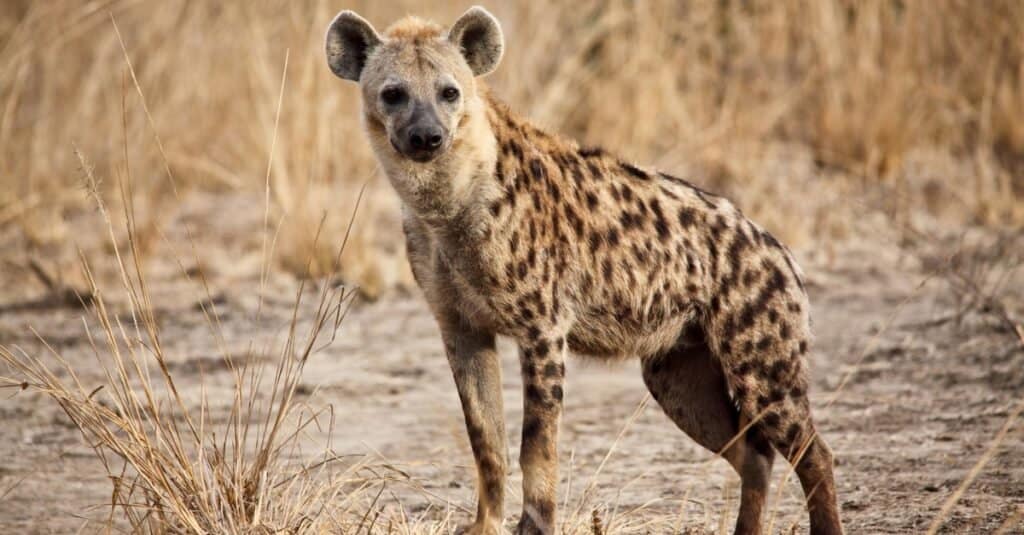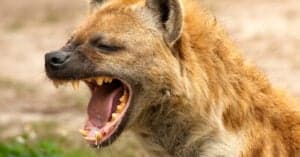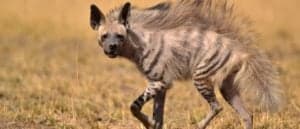Are Hyenas Dogs (Canines) or Cats (Felines) or Something Else Entirely?
What exactly is a hyena? Is it related to the cat or the dog? Is it a feline or a canine or something else entirely? The answer to that question is somewhat complicated. The hyena can be described as a “cat-like” animal, but it’s really a unique creature all by itself. Its anatomy, its vocalizations, and its highly social and structured “society” are shared by a few other creatures on the planet. Yet many misconceptions about them still abound. They are not wild dogs, and they are certainly not simple scavengers that rob graves and steal livestock.
Let’s start with the very basics: the hyena is a distinct family within the order of Carnivora. This family contains four existing species. The spotted hyena, the brown hyena, and the aardwolf are all native to sub-Saharan Africa. The striped hyena is endemic to northern Africa, the Middle East, and the Indian subcontinent. None of them are endangered, exactly, but the striped hyena and brown hyena are both threatened by habitat loss and hunting. Many more extinct species are known from the fossil record, dating back millions of years.
All four species share some peculiarities, but the spotted hyena is perhaps the strangest of all. It has undergone a significant amount of change in the last several million years to set it apart from other closely related animals. This article will cover some of these fascinating facts about how the hyena relates to both cats and dogs in terms of its anatomy and behavior.

Is the hyena a canine or a feline?
We already mentioned the fact that the hyena is a “cat-like” animal, but what does this mean exactly? It essentially means that the hyena isn’t a true feline like the tiger, leopard, and domesticated cat, which all belong to the family of Felidae. Instead, the hyena belongs to a separate grouping that’s more closely related to the feline branch than the canine branch.
To understand why it’s also important to understand a few basic facts about the evolutionary history of the hyena. The order Carnivora to which the hyena belongs first began to appear around 50 to 60 million years ago. These early carnivores developed specialized teeth for ripping and tearing flesh. Based at least on a partial reconstruction of the fossil record, we know that some of them may have resembled a modern weasel and were adapted for tree climbing.
The early carnivores split up very quickly into separate canine and feline lineages. Both branches went their separate ways, producing new and novel forms. Then around 30 million years ago, the feline lineage split off again into two major groups. One branch gave rise to the modern feline family. The other branch gave rise to hyenas, mongooses, and viverrids (like the Asian palm civet and the binturong). By around 10 to 20 million years ago, the hyena lineage really began to take shape as a unique and distinctive group. It branched out into at least three separate families, only one of which (the true hyenas) obviously still survives today. The changing environmental conditions within the last 10 million years eventually began to favor larger and more robust hyenas. They survived and flourished over the smaller, lightly built but endangered hyenas.
Although they last shared a common ancestor some 30 million years ago, felines, hyenas, mongooses, and viverrids all fall within a single category that taxonomists now call the Feliformia. This category, which derives from a Latin term meaning an animal with a cat-like form or appearance, is simply a description of their evolutionary relationship. It’s not a description of what they are. The hyena is no more a feline than the feline is a hyena.
How are hyenas similar to felines?
The evolutionary relationship between hyenas and cats might not be obvious at first because they look so different from each other. But there are actually a few traits they share in common. One defining trait that’s shared by nearly all members of Feliformia (the cat-like carnivores) is the unique skeletal structure of the middle and inner ear. It’s a very small difference (just a matter of one or two bones), but its presence in nearly all Feliformia suggests that it probably evolved early on in the lineage and was then passed on to all descending species.
Another similarity between hyenas and felines is the very rough tongue, composed of similarly sharp spines or bristles to help strip the flesh off prey and also to help with grooming. You might be amused to discover that the hyena grooms itself with the tongue in much the same manner as a cat as well: sitting on its back, legs spread out and feet pointed upward.
Besides a few other obvious similarities, however, hyenas and cats are very distinct animals. After all, 30 million years have passed since they last shared a common ancestor together. This is more than enough time for hyenas to have evolved into something very different. Thirty million years is greater, for instance than the length of time that separates humans from most apes and monkeys. So despite being members of Feliformia, hyenas aren’t actually very cat-like at all.

gualtiero boffi/Shutterstock.com
How do hyenas differ from felines?
Hyenas actually differ from felines in many different ways. One of the most important differences is the pack-like nature of their hunting strategy. While some species do prefer to scavenge for leftover food, hyenas are also talented and diligent predators. Unlike felines, they are generally unable to climb trees or ambush prey, preferring to chase them along the ground and tear them apart with their teeth rather than their claws (which are non-retractable anyway). These teeth actually bear more than a passing resemblance to canine teeth. This is probably because the teeth are very useful instruments for the hyena’s pack-like hunting strategy.
The hunting strategy is also a reflection of its social structure. The basis of the hyena society is the clan, which can consist of 80 members at a time and sometimes even more. However, even though hyenas work in unison to take down prey, life within the clan is not exactly a cooperative affair. There is fierce competition both between clans and within clans. The hyenas form very strict dominant hierarchies that determine access to both food and sex. Lower-ranked members of the clan may find themselves feasting on the last of the food. If there’s anything left over, they will hide it in their water holes for future meals, ensuring that nothing is wasted.
The striped hyena, the brown hyena, and the aardwolf have all adapted generally male-led societies. It’s the males who lead the clan and determine access to food and mates. However, hyena females possess some interesting traits. They have evolved male-like genitals and other characteristics. It’s not entirely clear why they would have evolved this, but it could be the fact that the females are generally exposed to higher levels of testosterone, giving them male characteristics, or it could be a byproduct of their highly aggressive and competitive social structure (females must compete with males beginning from early on in their lives).
Whatever the facts of the matter, the spotted hyena takes this to a particular extreme. Its societies are built around a matriarchal organization in which a single alpha female represents the core of the clan. She has preferential access to food and sex over the other females, who in turn have their own dominance rankings. Males are generally ranked lower than females within the clan hierarchy. They must wait until the females have had their turn to feed on the carcass before eating as well. The female’s anatomy is also utterly unlike any canine or feline (or perhaps any mammal in general). Their bodies are 10% larger than the male and possess even more male-like external genitals. As you might imagine, birth is a particularly arduous process and has endangered the lives of many mothers.
In Summation
To sum up everything in this article, we can safely say that hyenas are more closely related to cats than dogs. However, this relationship is rather distant and remote. They last shared a common ancestor with felines some 30 million years ago. This has given hyenas plenty of time to develop and evolve their own unique characteristics and traits, some of which are shared by a few other animals on the planet.
Next Up: Baby Whales: 5 Pictures and 5 Facts
More from A-Z Animals
What exactly is a hyena? Is it related to the cat or the dog? Is it a feline or a canine or something else entirely? The answer to that question is somewhat complicated. The hyena can be described as a “cat-like” animal, but it’s really a unique creature all by itself. Its anatomy, its vocalizations, and its highly social and structured “society” are shared by a few other creatures on the planet. Yet many misconceptions about them still abound. They are not wild dogs, and they are certainly not simple scavengers that rob graves and steal livestock.
Let’s start with the very basics: the hyena is a distinct family within the order of Carnivora. This family contains four existing species. The spotted hyena, the brown hyena, and the aardwolf are all native to sub-Saharan Africa. The striped hyena is endemic to northern Africa, the Middle East, and the Indian subcontinent. None of them are endangered, exactly, but the striped hyena and brown hyena are both threatened by habitat loss and hunting. Many more extinct species are known from the fossil record, dating back millions of years.
All four species share some peculiarities, but the spotted hyena is perhaps the strangest of all. It has undergone a significant amount of change in the last several million years to set it apart from other closely related animals. This article will cover some of these fascinating facts about how the hyena relates to both cats and dogs in terms of its anatomy and behavior.

Is the hyena a canine or a feline?
We already mentioned the fact that the hyena is a “cat-like” animal, but what does this mean exactly? It essentially means that the hyena isn’t a true feline like the tiger, leopard, and domesticated cat, which all belong to the family of Felidae. Instead, the hyena belongs to a separate grouping that’s more closely related to the feline branch than the canine branch.
To understand why it’s also important to understand a few basic facts about the evolutionary history of the hyena. The order Carnivora to which the hyena belongs first began to appear around 50 to 60 million years ago. These early carnivores developed specialized teeth for ripping and tearing flesh. Based at least on a partial reconstruction of the fossil record, we know that some of them may have resembled a modern weasel and were adapted for tree climbing.
The early carnivores split up very quickly into separate canine and feline lineages. Both branches went their separate ways, producing new and novel forms. Then around 30 million years ago, the feline lineage split off again into two major groups. One branch gave rise to the modern feline family. The other branch gave rise to hyenas, mongooses, and viverrids (like the Asian palm civet and the binturong). By around 10 to 20 million years ago, the hyena lineage really began to take shape as a unique and distinctive group. It branched out into at least three separate families, only one of which (the true hyenas) obviously still survives today. The changing environmental conditions within the last 10 million years eventually began to favor larger and more robust hyenas. They survived and flourished over the smaller, lightly built but endangered hyenas.
Although they last shared a common ancestor some 30 million years ago, felines, hyenas, mongooses, and viverrids all fall within a single category that taxonomists now call the Feliformia. This category, which derives from a Latin term meaning an animal with a cat-like form or appearance, is simply a description of their evolutionary relationship. It’s not a description of what they are. The hyena is no more a feline than the feline is a hyena.
How are hyenas similar to felines?
The evolutionary relationship between hyenas and cats might not be obvious at first because they look so different from each other. But there are actually a few traits they share in common. One defining trait that’s shared by nearly all members of Feliformia (the cat-like carnivores) is the unique skeletal structure of the middle and inner ear. It’s a very small difference (just a matter of one or two bones), but its presence in nearly all Feliformia suggests that it probably evolved early on in the lineage and was then passed on to all descending species.
Another similarity between hyenas and felines is the very rough tongue, composed of similarly sharp spines or bristles to help strip the flesh off prey and also to help with grooming. You might be amused to discover that the hyena grooms itself with the tongue in much the same manner as a cat as well: sitting on its back, legs spread out and feet pointed upward.
Besides a few other obvious similarities, however, hyenas and cats are very distinct animals. After all, 30 million years have passed since they last shared a common ancestor together. This is more than enough time for hyenas to have evolved into something very different. Thirty million years is greater, for instance than the length of time that separates humans from most apes and monkeys. So despite being members of Feliformia, hyenas aren’t actually very cat-like at all.

gualtiero boffi/Shutterstock.com
How do hyenas differ from felines?
Hyenas actually differ from felines in many different ways. One of the most important differences is the pack-like nature of their hunting strategy. While some species do prefer to scavenge for leftover food, hyenas are also talented and diligent predators. Unlike felines, they are generally unable to climb trees or ambush prey, preferring to chase them along the ground and tear them apart with their teeth rather than their claws (which are non-retractable anyway). These teeth actually bear more than a passing resemblance to canine teeth. This is probably because the teeth are very useful instruments for the hyena’s pack-like hunting strategy.
The hunting strategy is also a reflection of its social structure. The basis of the hyena society is the clan, which can consist of 80 members at a time and sometimes even more. However, even though hyenas work in unison to take down prey, life within the clan is not exactly a cooperative affair. There is fierce competition both between clans and within clans. The hyenas form very strict dominant hierarchies that determine access to both food and sex. Lower-ranked members of the clan may find themselves feasting on the last of the food. If there’s anything left over, they will hide it in their water holes for future meals, ensuring that nothing is wasted.
The striped hyena, the brown hyena, and the aardwolf have all adapted generally male-led societies. It’s the males who lead the clan and determine access to food and mates. However, hyena females possess some interesting traits. They have evolved male-like genitals and other characteristics. It’s not entirely clear why they would have evolved this, but it could be the fact that the females are generally exposed to higher levels of testosterone, giving them male characteristics, or it could be a byproduct of their highly aggressive and competitive social structure (females must compete with males beginning from early on in their lives).
Whatever the facts of the matter, the spotted hyena takes this to a particular extreme. Its societies are built around a matriarchal organization in which a single alpha female represents the core of the clan. She has preferential access to food and sex over the other females, who in turn have their own dominance rankings. Males are generally ranked lower than females within the clan hierarchy. They must wait until the females have had their turn to feed on the carcass before eating as well. The female’s anatomy is also utterly unlike any canine or feline (or perhaps any mammal in general). Their bodies are 10% larger than the male and possess even more male-like external genitals. As you might imagine, birth is a particularly arduous process and has endangered the lives of many mothers.
In Summation
To sum up everything in this article, we can safely say that hyenas are more closely related to cats than dogs. However, this relationship is rather distant and remote. They last shared a common ancestor with felines some 30 million years ago. This has given hyenas plenty of time to develop and evolve their own unique characteristics and traits, some of which are shared by a few other animals on the planet.
Next Up: Baby Whales: 5 Pictures and 5 Facts




